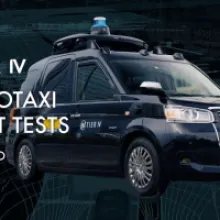SHERIDAN, WYOMING – Feb. 28, 2025 – Tier IV, a pioneer in open-source autonomous driving software, has successfully concluded a series of robotaxi service pilot tests across Tokyo, Japan. These tests, conducted in Odaiba in November 2024 and Nishi-Shinjuku in December 2024, mark a crucial step towards the commercialization of robotaxi services and their integration into Japan’s transportation infrastructure.
Strategic Testing and Adaptation
The pilot tests were designed to demonstrate the feasibility of introducing robotaxis by adapting and expanding existing operational design domains (ODDs) to accommodate diverse and challenging traffic environments. These in-depth technical verifications were crucial for the broader deployment of robotaxis.
Utilizing JPN Taxi vehicles equipped with Tier IV’s advanced autonomous driving system, the tests navigated approximately 500 complex scenarios in both Odaiba and Nishi-Shinjuku. These scenarios included executing right and left turns at busy intersections and safely maneuvering around parked vehicles. A safety-first approach was implemented, allowing operators to switch to manual control when scenarios exceeded the predefined ODDs.
Odaiba Pilot Test: User Interaction and Feedback
In Odaiba, the pilot program focused on user interaction and experience. Passengers were able to set their destinations using voice commands, and the robotaxi navigated routes around Tokyo Teleport Station. Each ride averaged approximately 3 kilometers, contributing to a total driving distance of around 354 kilometers.
Post-ride surveys were conducted to gather valuable user feedback, allowing Tier IV to identify potential improvements and enhance the overall service quality. This direct feedback loop is essential for refining the user experience and ensuring widespread acceptance of robotaxi services.
Nishi-Shinjuku Pilot Test: Navigating Dense Urban Environments
The Nishi-Shinjuku pilot test focused on navigating the dense pedestrian and vehicular traffic of one of Tokyo’s busiest areas. Passengers used a ride-hailing application to select from seven destination options, and the robotaxi navigated along designated routes.
Tier IV engaged with the Shinjuku Subcenter Area Environmental Improvement Committee and other stakeholders to discuss the scalability of robotaxi operations in the area. This test was supported by a subsidy from the Shinjuku Station West Exit Area Parking Region Rules Operation Council. Each ride averaged approximately 3 kilometers, with a total accumulated driving distance of around 622 kilometers.
Key Findings and Future Steps
The outcomes of these pilot tests confirmed the adaptability of ODDs in dense traffic conditions and identified critical technical challenges that need to be addressed to enable autonomous driving across a wide range of routes.
According to Tier IV, “These tests demonstrated the process of introducing robotaxis by adapting and expanding existing operational design domains (ODDs) to accommodate new traffic environments. In-depth technical verifications for the broader deployment of robotaxis were also conducted.”
Moving forward, Tier IV will integrate the findings from these tests into its reference design for robotaxis, which will be shared with key players in the automotive industry. The company states that this will significantly lower the entry barrier for developing vehicles suitable for robotaxis, enabling auto makers to enter the market.
Towards Nationwide Deployment
By 2027, Tier IV aims to establish a service model that facilitates the launch of robotaxi operations within three months in target regions by leveraging the reference design. The model has the potential to play an important role in advancing the nationwide deployment and integration of robotaxis across society.
As stated by the company, “By 2027, Tier IV aims to establish a service model that facilitates the launch of robotaxi operations within three months in target regions by leveraging the reference design. The model has the potential to play an important role in advancing the nationwide deployment and integration of robotaxis across society.”
This strategic approach will help pave the way for a future where autonomous transportation is a seamless and integral part of daily life in Japan.
For more information visit.
